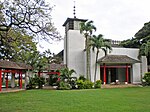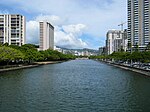Honolulu Stadium
1926 establishments in Hawaii1976 disestablishments in HawaiiAmerican football venues in HawaiiAthletics (track and field) venues in HawaiiBaseball venues in Hawaii ... and 17 more
Buildings and structures in HonoluluDefunct American football venues in the United StatesDefunct baseball venues in the United StatesDefunct boxing venues in the United StatesDefunct college football venuesDefunct motorsport venues in the United StatesDefunct sports venues in HawaiiDemolished sports venues in the United StatesFormer music venues in the United StatesHawaii Rainbow Warriors footballHistory of OahuMotorsport venues in HawaiiSports in HonoluluSports venues completed in 1926Sports venues demolished in 1976The HawaiiansWorld Football League venues
Honolulu Stadium was a multi-purpose stadium located in the Moʻiliʻili district of Honolulu, Hawai'i, at the corner of King and Isenberg Streets. Opened in 1926, it was the primary sports venue in Hawaiʻi preceding Aloha Stadium. During its final years, the stadium could hold about 25,000 fans; it was demolished in 1976. A public park, Old Stadium Park, now occupies the location. A plaque at the corner of King and Isenberg commemorates the stadium. Some of the property wall that stood behind the stands on the west end still remains.
Excerpt from the Wikipedia article Honolulu Stadium (License: CC BY-SA 3.0, Authors).Honolulu Stadium
Plaza de Santa Ana, Madrid
Geographical coordinates (GPS) Address Nearby Places Show on map
Geographical coordinates (GPS)
| Latitude | Longitude |
|---|---|
| N 21.293 ° | E -157.827 ° |
Address
Parking de Santa Ana
Plaza de Santa Ana
28012 Madrid (Centro)
Comunidad de Madrid, España
Open on Google Maps





